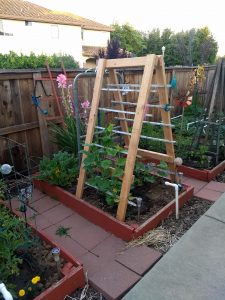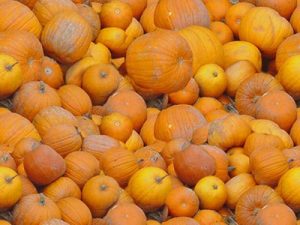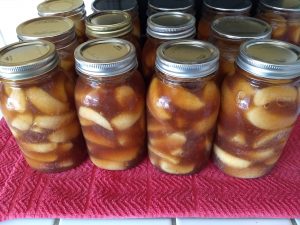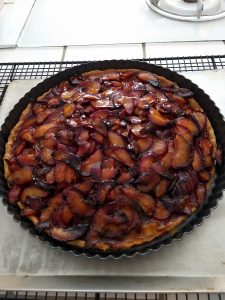Canning – Preserving the Bounty of Our Summer Gardens
Many of us enjoy having a garden in the back yard. Do you? Are you skilled in the art of preserving the bounty of your summer garden by making jam or jelly, canning or dehydrating your fruits and vegetables or baking it into bread? So far we have made apricot jam, apricot pie filling, cherry jam, cherry pie filling, cherry plum jam, Chinese plum sauce, banana bread, spicy plum sauce, dried figs, mango jam, nectarine jam, orange marmalade, orangesicle jam, pineapple jam, pineapple and Jalapeno salsa, plum jam, pluot jam, pluerry jam, peach jam, peach pie filling, red pepper jam, strawberry jam, zuccini relish, zucchini bread, diced tomatoes, tomato sauce, tomato juice, dried tomato powder, canned peach slices, canned asian pear slices, fruit cocktail, sweet pickle relish, dill pickles, canned ground hamburger, canned italian sausage, smoky tomato salsa, and vanilla pear sauce. Still in the plans are apple butter, apple pie filling, persimmon jam and more diced tomatoes. Do you make and can jam or any of the above?
Of course we have more zucchini than we can eat. Do you shred it and add it to zucchini bread? How about dehydrating it and using it in place of Panko bread crumbs. We especially enjoy tomatoes that taste like the tomatoes we enjoyed as kids. Some of us even have a few fruit trees or blueberry bushes or a strawberry patch, or know someone who does.
Usually, you soon find yourself with more than you can eat fresh, so we turn to canning to enjoy those fruits and vegetables through the winter. If you don’t have a garden, you know that you can find fresh fruit and produce at our many Farmer’s Markets or Pumpkin Patches.
The purpose of this page, and the pages and posts that are linked here, is to share the joy of canning to preserve the bounty of our summer gardens. I don’t know about you but I really enjoy fruit pies, but not just during peach season or apple season.
I want fruit pies the rest of the year too. If you want to learn to can your fruit and vegetables, check with the U.C. Master Gardener Program.
Not only does California have a great extension service, several other states do as well. When I first learned about canning fruit pie filling, I obtained the info and the Clear Jel from the Oregon University Extension Service office in Redmond Oregon. That page is currently not available online but there is one from Washington State University about canning fruit pie filling. As noted above, we have canned apple, apricot, peach and cherry pie filling. When I can apple pie filling I like to save the peels and cores and use them to make apple butter. Check out this apple butter recipe. Amazing Apple Butter Recipe _ Allrecipes
We don’t can pumpkin pie filling because it is too dense to be sure that enough heat can penetrate to the center of the jar for long enough to make sure it is safe, but we do can cubed pumpkin or butternut or Hubbard squash that can later be mashed for pumpkin pie filling. I prefer the butternut squash because it is mostly usable product, not a large balloon shaped fruit full of air and very little useable product. The butternut squash is also much easier to peel.
Those of us who grew up with a mom or grandmother who canned, and who took up the activity as we got older, know that the processes have changed as we learned more about food safety. Most of us know that we can use the water bath or steam bath canning methods for high acid fruits and pickles and most tomato products if we add a little bottled lemon juice to the tomatoes. It seems that the producers of tomato starts have bred in more sweetness and less acid that what we grew as kids, hence the need for bottled lemon juice with today’s tomatos. We also know, that although our parents used those processes for other vegetables and even meats, the processing time was often in excess of hours, not minutes, to make sure to kill the botulism spores. For example, beef stew was 3 hours. These days, most of us have moved on the pressure canning for vegetables and meats.
I know that some of you will say that if it was safe enough for my grandmother, then the old methods are safe enough for me. All I can say to that is please don’t share your canned meat and vegetables with me or my friends unless they have been safely canned using a pressure canner. Yes, I know that you will say that you don’t know anyone who died from your grandmother’s canned green beans, but that is not good enough for me. How many of her relatives had a “24 hour flu” within a day or two of eating those green beans? You do know that there isn’t such a thing as a “24 hour flu” don’t you. They probably had food poisoning from those green beans.
Enough of my soap box about proper canning methods. Just know that I will only share safe, proven, recipes on my website. Recipes that have been tested by the National Center for Home Food Preservation or Ball or Kerr, or the University of California Extension Service. Did you know that it the spring of 2024 the link for the National Center for Home Food Preservation was moved to the University of Georgia. The link above has been corrected to show the new site.
If you want to learn more, you can follow canning groups on Facebook, but bear in mind, some will still try to convince you that the open kettle or oven canning are ok. Well, they are no longer approved methods according to the National Center for Home Food Preservation and that is good enough for me. I follow these groups on Facebook in my spare time: “Food in Jars Community”, “Canning, Dehydrating and Long Term Food Storage”, and “Food Storage, Survivalism and Preparedness” .
There is additional information about canning on the USDA website, https://www.nifa.usda.gov/about-nifa/blogs/usdas-complete-guide-home-canning, but it also will suggest that you visit the National Center for Home Food Preservation.





